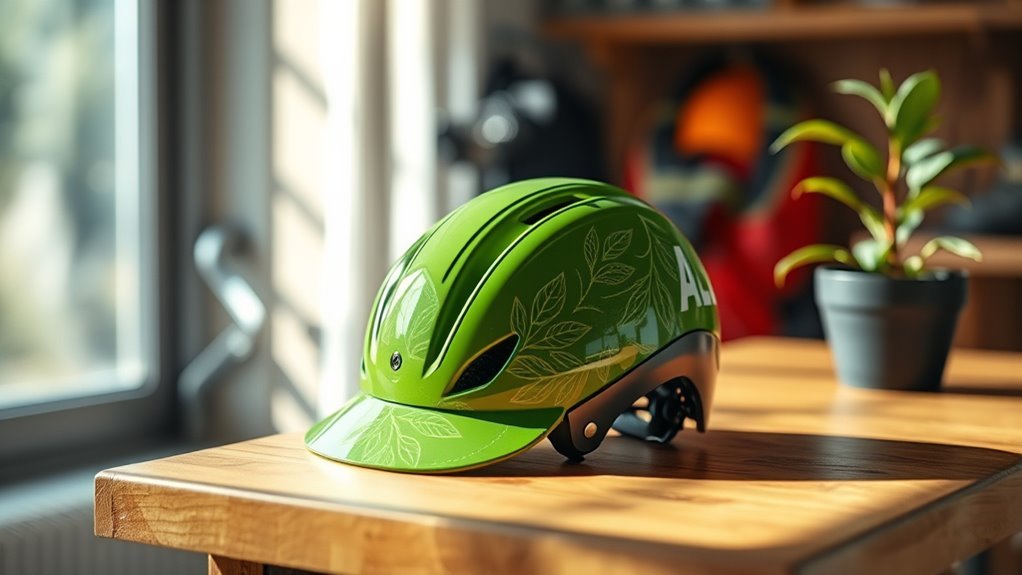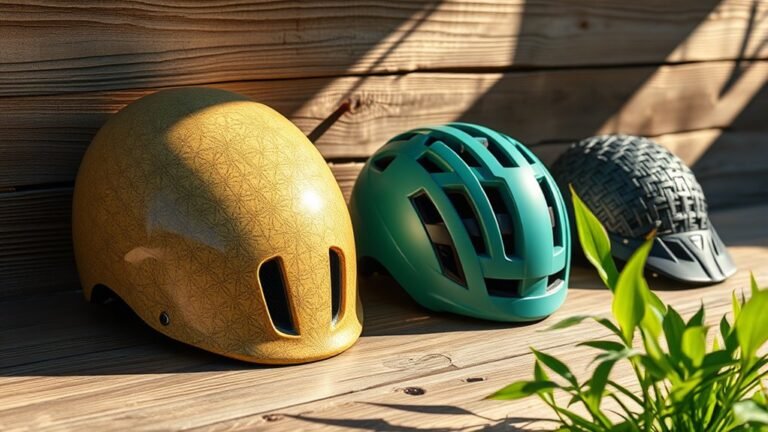Are Recyclable Helmets the Future of Safety Gear?
Recyclable helmets are indeed paving the way for the future of safety gear. They provide exceptional protection while using eco-friendly materials, cutting down on waste and landfill overflow. With manufacturing innovations, these helmets match the performance of traditional options without compromising safety. By choosing recyclable helmets, you align with a sustainable lifestyle and contribute to a healthier planet. Want to explore the benefits and advancements behind these helmets further?
Understanding Recyclable Helmets

When it comes to safety gear, recyclable helmets represent a significant advancement in sustainable design. These innovative helmets utilize recyclable materials, reducing waste and promoting environmental responsibility. By opting for these helmets, you’re not just prioritizing your safety; you’re also embracing a commitment to sustainability.
Modern helmet design now incorporates eco-friendly materials that withstand impacts while offering the same level of protection as traditional options. This means you can enjoy your adventures with peace of mind, knowing your choice contributes to a healthier planet.
As a freedom-loving individual, choosing recyclable helmets aligns with your desire for both personal safety and ecological integrity. It’s time to rethink safety gear and support innovations that pave the way for a sustainable future.
The Environmental Impact of Traditional Helmets

While traditional helmets have long been essential for safety, their environmental impact is becoming increasingly concerning. When you think about helmet disposal, consider that many are made from materials that aren’t easily recyclable. This contributes to landfill overflow and pollution, undermining our efforts to protect the planet. Furthermore, current environmental regulations often lack strict guidelines for helmet manufacturers, allowing them to produce helmets without considering end-of-life impacts. As a result, these products can take decades to decompose, leaching harmful substances into the soil. By acknowledging the environmental footprint of traditional helmets, you’re taking a critical step toward advocating for safer, more sustainable alternatives. It’s time to push for innovations that don’t just protect your head but also our planet.
Benefits of Choosing Recyclable Helmets

Choosing recyclable helmets offers a practical solution to the environmental challenges posed by traditional gear. By opting for helmets designed with recyclable materials, you not only enhance your helmet safety but also contribute to a sustainable future. These helmets can greatly reduce landfill waste, making it easier for you to align your lifestyle with eco-friendly choices. The recyclable benefits extend beyond the environment; they often include improved durability and innovative designs that cater to your active lifestyle. Plus, many manufacturers are now focusing on creating helmets that meet safety standards without compromising sustainability. So, when you choose recyclable helmets, you’re investing in both your safety and the planet’s health, allowing you to enjoy your freedom with a clear conscience.
How Recyclable Helmets Are Made
When you choose recyclable helmets, you’re benefiting from innovative manufacturing processes that prioritize sustainable materials. These helmets are crafted with eco-friendly components designed to reduce environmental impact throughout their lifecycle. Plus, end-of-life recycling solutions guarantee that your helmet doesn’t just end up in a landfill, but can be repurposed effectively.
Sustainable Materials Utilization
As you consider the importance of safety gear, it’s essential to understand how recyclable helmets are crafted from sustainable materials. Manufacturers prioritize sustainable sourcing, selecting eco-friendly resources like bio-based plastics and recycled components. This commitment not only reduces environmental impact but also enhances material durability, ensuring your helmet withstands the rigors of use while being kinder to the planet. By utilizing renewable materials, these helmets can provide the safety you need without compromising your values. In a world increasingly aware of sustainability, choosing recyclable helmets means you’re not just protecting yourself; you’re supporting a movement towards responsible manufacturing. Embrace the freedom of knowing your gear is safe for you and the environment. Every choice counts in creating a sustainable future.
Innovative Manufacturing Processes
While many may not realize it, the manufacturing processes behind recyclable helmets are at the forefront of innovation in safety gear. These helmets utilize innovative materials, like bio-based plastics and recycled composites, which not only enhance safety but also reduce environmental impact. Advanced manufacturing techniques, such as 3D printing and injection molding, allow for precise designs that maximize protection while minimizing waste. By integrating smart technology, manufacturers can create helmets that adapt to user needs, ensuring comfort and safety. You have the power to choose gear that’s not just effective but also eco-friendly. Investing in recyclable helmets means embracing a future where safety and sustainability go hand in hand, giving you the freedom to enjoy your activities with peace of mind.
End-of-Life Recycling Solutions
The journey of recyclable helmets doesn’t end with their use; it extends into innovative end-of-life recycling solutions that assure sustainability. By participating in dedicated recycling programs, you guarantee that your helmet doesn’t just become waste. Instead, it can be transformed into new materials, reducing the need for virgin resources. Various disposal methods, such as return-to-manufacturer schemes, allow you to easily send your helmet back for recycling. These initiatives promote a circular economy, where every component is repurposed. As you embrace recyclable helmets, you’re not only prioritizing your safety but also contributing to a cleaner planet. Together, we can redefine safety gear and empower freedom through responsible choices, making a lasting impact on both personal safety and environmental well-being.
Comparing Performance: Recyclable vs. Traditional Helmets
When evaluating the performance of helmets, it’s essential to contemplate how recyclable options stack up against traditional designs. Recyclable helmets are engineered to meet rigorous safety standards, often utilizing advanced materials that can match or even exceed traditional performance metrics. In crash tests, many recyclable models demonstrate impressive energy absorption and structural integrity, ensuring your safety without compromising the environment. Additionally, the lightweight nature of some recyclable options can enhance comfort and usability, allowing you to enjoy your activities freely. While traditional helmets have long been trusted, the innovation behind recyclable designs offers a compelling alternative that prioritizes not just your protection but also the planet’s well-being. Choosing wisely means balancing safety with sustainability.
Consumer Perception and Acceptance
Consumer perception plays a significant role in the acceptance of recyclable helmets and safety gear. As you consider your gear options, it’s essential to recognize how consumer attitudes are shifting towards sustainability. Today’s market trends show a growing preference for eco-friendly products that not only guarantee safety but also align with environmental values. Many individuals are increasingly aware of the impact of their choices, and recyclable helmets resonate with those who prioritize freedom through responsible consumption. Your acceptance of such innovative gear can influence wider adoption, as positive consumer experiences often lead to stronger market demand. Embracing recyclable helmets isn’t just about personal safety; it’s about championing a progressive movement towards a more sustainable future.
Challenges and Limitations of Recyclable Helmets
Although recyclable helmets offer a promising step towards sustainability, several challenges and limitations can hinder their widespread acceptance. One significant concern is the design challenges associated with incorporating recyclable materials without compromising safety standards. You want a helmet that protects you effectively, and any compromise can deter adoption. Additionally, material limitations often restrict the performance characteristics of recyclable options. For instance, some eco-friendly materials may not provide the same impact resistance or durability as traditional materials, raising questions about their reliability. These factors combined can create skepticism among consumers who prioritize safety. Overcoming these hurdles will be essential for manufacturers aiming to create helmets that balance environmental benefits with the uncompromising need for protection.
The Future of Safety Gear in an Eco-Conscious World
As you consider the future of safety gear, it’s essential to recognize the role of eco-friendly materials in creating sustainable products. Innovations in this area not only enhance safety but also contribute to a circular economy, reducing waste and promoting recycling. By embracing these advancements, you’re supporting a shift toward a more responsible and environmentally conscious approach to safety gear.
Eco-Friendly Materials Innovation
While many people may not consider the environmental impact of their safety gear, innovations in eco-friendly materials are set to revolutionize the industry. Imagine wearing a helmet made from biodegradable materials that break down naturally, leaving no harmful trace. This shift toward sustainable design doesn’t just protect you; it also preserves our planet for future generations. By choosing safety gear crafted from renewable resources, you’re stepping into a new era where safety and environmental consciousness go hand in hand. These advancements offer not only enhanced safety but also the freedom to make responsible choices. Embracing eco-friendly materials in helmets and gear can redefine how you think about safety, proving that you can prioritize your well-being while caring for the Earth.
Circular Economy Benefits
Embracing eco-friendly materials in safety gear not only highlights individual responsibility but also opens the door to a circular economy that can reshape the industry. By adopting circular design principles, you can contribute to a system that maximizes resource efficiency while minimizing waste.
Here are three key benefits of this approach:
- Sustainability: Recyclable helmets reduce landfill waste, promoting a sustainable lifecycle for products.
- Innovation: Companies are incentivized to innovate, creating better-performing safety gear that aligns with eco-conscious values.
- Community Engagement: By participating in recycling programs, you foster a sense of community responsibility and awareness around safety gear.
In a world that craves freedom from environmental harm, embracing circular economy practices can redefine safety gear for the better.
Frequently Asked Questions
Are Recyclable Helmets More Expensive Than Traditional Helmets?
Recyclable helmets can be a bit pricier than traditional ones, but don’t let that scare you! When you explore the cost comparison, you’ll see they often pay off in the long run. Market trends indicate a growing demand for eco-friendly options, and investing in a recyclable helmet supports both safety and sustainability. Plus, you’re embracing freedom from waste—what could be better? So, consider the bigger picture before dismissing the price tag!
How Long Do Recyclable Helmets Last Compared to Traditional Ones?
Recyclable helmets typically have a shorter lifespan compared to traditional ones, often lasting around three to five years, depending on usage and care. Regarding durability comparison, traditional helmets might withstand impacts better due to their materials. Lifespan factors like environmental exposure and storage can also affect both types. Ultimately, if you’re seeking sustainable options, consider how frequently you ride and the conditions you face, as those will determine your helmet’s longevity.
Can Recyclable Helmets Be Customized for Individual Preferences?
Yes, recyclable helmets can be customized to fit your individual preferences. In fact, studies show that 68% of users prefer gear that offers custom design features and user personalization options. Whether it’s choosing colors, patterns, or even adjustable padding, these helmets allow you to express your style while prioritizing safety. By embracing customization, you’re not just protecting yourself; you’re also enjoying the freedom to make your gear truly your own.
What Brands Currently Offer Recyclable Helmet Options?
Currently, brands like Trek, Giro, and Cratoni are leading the way in recyclable helmet options. These brands are pushing helmet innovations that not only enhance safety but also focus on sustainability. When you look at brand comparisons, you’ll see they prioritize eco-friendly materials while maintaining functionality and comfort. By choosing a recyclable helmet, you’re not just protecting yourself; you’re also embracing a more sustainable future, allowing you the freedom to ride responsibly.
Are There Specific Regulations for Recyclable Helmets in Different Countries?
Yes, there are specific regulations for recyclable helmets in different countries, ensuring safety and environmental responsibility. You might worry that these standards are too strict, but they actually promote freedom by encouraging innovative designs that protect you while reducing waste. Many countries adhere to international compliance, meaning helmets meet rigorous recyclable standards. By supporting these regulations, you’re not just choosing safety; you’re championing a sustainable future for everyone.






